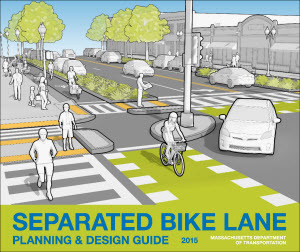 The Massachusetts Department of Transportation has published planning and design guide for separated bike lanes, which focuses on constructed, curb-separated lanes, also called cycle tracks. The document provides details on the lanes' planning, cross section and intersection design, intersection operations, curbside management, and maintenance. The guide is a complement to the recently released Federal Highway Administration Separated Bike Lane Planning and Design Guide, which focuses more on pilot project retrofits.
The Massachusetts Department of Transportation has published planning and design guide for separated bike lanes, which focuses on constructed, curb-separated lanes, also called cycle tracks. The document provides details on the lanes' planning, cross section and intersection design, intersection operations, curbside management, and maintenance. The guide is a complement to the recently released Federal Highway Administration Separated Bike Lane Planning and Design Guide, which focuses more on pilot project retrofits.
This guide also presents considerations and strategies for the development of separated bike lanes and provides a framework for determining when separated bike lanes are both appropriate and feasible. It also presents guidance for separation strategies, bike lane configuration, and considerations for transit stops, loading zones, utilities, drainage, parking, and landscaping. The document defines separated bike lane design principles for intersections, introduces intersection design treatments, and provides examples of typical intersection configurations. It clarifies when to consider signalization and provides guidance on signal phasing and timing and even the appropriate location of signal equipment. The guide concludes with maintenance strategies, including seasonal operations and maintenance considerations.